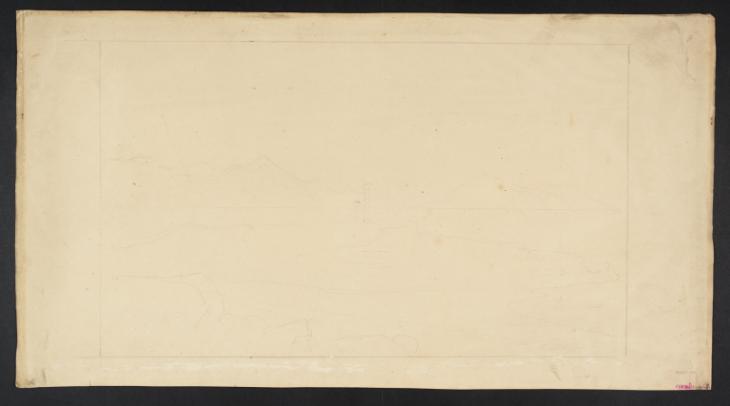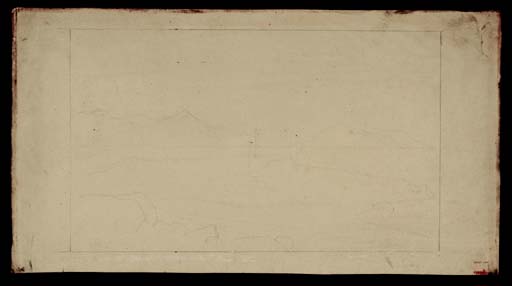Joseph Mallord William Turner Classical Ruins on a Rocky Shore with Distant Mountains c.1830-40
Image 1 of 2
Joseph Mallord William Turner,
Classical Ruins on a Rocky Shore with Distant Mountains
c.1830-40
Joseph Mallord William Turner 1775–1851
Classical Ruins on a Rocky Shore with Distant Mountains c.1830–40
D34925
Turner Bequest CCCXLIV 428
Turner Bequest CCCXLIV 428
Pencil on white wove paper, 301 x 559 mm
Inscribed in red ink ‘cccxliv.425’ with the ‘5’ corrected to ‘8’ bottom right
Stamped in black ‘CCCXLIV 428’ bottom right
Inscribed in red ink ‘cccxliv.425’ with the ‘5’ corrected to ‘8’ bottom right
Stamped in black ‘CCCXLIV 428’ bottom right
Accepted by the nation as part of the Turner Bequest 1856
References
1830
A.J. Finberg, A Complete Inventory of the Drawings of the Turner Bequest, London 1909, vol.II, p.1149, CCCXLIV 428, as ‘Study for one of the Bible Illustrations’, c.1830–41.
Finberg called this large, faint drawing a ‘Study for one of the Bible Illustrations’,1 presumably thinking of the series of twenty-six watercolour designs Turner produced between about 1832 and 1835 from topographical drawings by other artists, to be engraved for Edward and William Finden’s Landscape Illustrations of the Bible, later issued by John Murray in The Biblical Keepsake2 (Tate impressions: T05152–T05175, T06653–T06654).
The composition shows a single tall column and a smaller vertical feature to its left, standing on a barren promontory at the centre, bisecting the ruled horizon, above which mountains arise on the far side of a lake or bay. The design is defined by ruled lines within an area of 250 x 420 mm, considerably larger than the approximately 120–140 x 200 mm dimensions of the Finden watercolours, and a direct link to the series is perhaps unlikely.
The subject may be the coast of the Mediterranean or Aegean, with the column(s) as the last traces of a larger classical building. Compare the settings of the more substantial remains in watercolours of the ruined Temple of Minerva, Cape Colonna (Sunium) (Townley Hall Art Gallery and Museum, Burnley),3 engraved in 1832 for Finden’s Landscape Illustrations to Byron (Tate impression: T06178), and The Temple of Poseidon at Sunium (Cape Colonna) of about 1834 (Tate T07561).4 See also the earlier pair of paintings, The Temple of Jupiter Panellenius Restored and View of the Temple of Jupiter Panellenius in the Island of Aegina, with the Greek National Dance of the Romaika, exhibited in 1816 (private collections).5
Very similar in its size and technique to the present work, Tate D34926 (Turner Bequest CCCXLIV 429) shows a related composition, and the two were perhaps ideas for a pair of thematically linked watercolours or paintings. Finberg placed them somewhat arbitrarily in a large ‘Miscellaneous: black and white’ category dated to about 1830–41;6 the range has modified slightly here to cover the 1830s in case definite connections to Turner’s illustrative work of that period comes to light.
Andrew Wilton, J.M.W. Turner: His Life and Work, Fribourg 1979, pp.447–50 nos.1236–1263, most reproduced (various collections).
Technical notes:
The paper is heavyweight, verging on card. There are deposits of white paper adhering along the lower edge.
Verso:
Blank; deposits of glue from previous mounting; inscribed in pencil ‘TOP’ at centre; inscribed in pencil ‘cccxliv.428’ towards bottom left.
Matthew Imms
August 2016
How to cite
Matthew Imms, ‘Classical Ruins on a Rocky Shore with Distant Mountains c.1830–40 by Joseph Mallord William Turner’, catalogue entry, August 2016, in David Blayney Brown (ed.), J.M.W. Turner: Sketchbooks, Drawings and Watercolours, Tate Research Publication, March 2017, https://www


